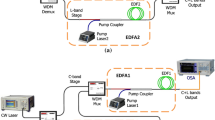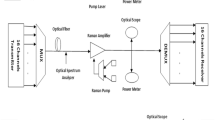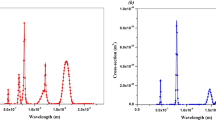Abstract
In this paper, the erbium doped fiber amplifier (EDFA) is used as a booster and a pre amplifier in the dense wavelength division multiplexing system. We optimize the design parameters of the EDFA using the multi parameter optimization tools. The gain profile of the EDFA depend on the fiber length, Er3+ ion density, Er3+ doping radius at pump wavelength λp = 980 nm while the operating frequency range is 1546 nm to 1552 nm. The optimized EDFA length is found to be 8 m at 50 mW pump power which gives a maximum gain of 40 dB and 39.5 dB for co-pumping and bidirectional pumping respectively. The analysis to obtain the optimized parameters of the EDFA is done on the basis of gain, noise figure and the optical signal to noise ratio varying the input power of 0 dBm–30 dBm.
Similar content being viewed by others
Avoid common mistakes on your manuscript.
1 Introduction
The optical regenerators were used to amplify the signal passing through the fiber prior to the EDFA which were very expensive. Disurvire et al. [1] invented a high gain EDFA which was able to amplify optical signals in the C band from 1530 nm to 1565 nm providing a minimum gain up to 30 dB. EDFA is used to compensate attenuation losses in order to transmit signals over a long distance and can be operated in low loss optical window.
DWDM is a technology which multiplexes many channels in a single fiber. Ismail et al. designed a WDM optical network in terms of length and optical power. He presented a optimized EDFA to achieve a flattened gain within 38 ± 0.5 dB in WDM system [2]. Aljaff et al. optimized the parameters of EDFA at pump wavelength λp = 980 nm and λs = 1552.5 nm. He observed that bidirectional pumping schemes gives flat gain as compared to co propagating and counter propagating pumping configurations [3]. Mahad et al. [4] worked on gain flattening and achieved gain flatness of 24 ± 0.29 dB from 1546 nm to 1558 nm. Sivanantha Raja et al. [5] has demonstrated forward pumping schemes of the hybrid amplifier EYDFA with the RAMAN amplifier gives superior performances than other pumping configurations. Multi parameter optimization (MPO) of design parameters of RAMAN amplifier in DWDM system using Genetic algorithm has been investigated in [6]. The MPO of the EDFA at data rate 40 Gbps in 16 channel DWDM system is presented in [7]. Removing the C-band ASE, an efficient double pass EDFA is achieved in [8]. The hybrid optical amplifiers in the DWDM systems with reduced channel spacing at different data rates are studied in [9]. In this paper, we have shown that the bidirectional pumping is best in order to obtain a high gain and a low NF [10].
2 Simulation Setup
Pump powers, fiber length and frequency spacing of input signal are optimized using multi parameter optimization tools aiming to maximize the gain and minimize the noise figure of EDFA.
3 Design and Analysis of EDFA
The above Fig. 1 shows design of the multipara meter optimization EDFA consists of a 16 input channels DWDM transmitter, ideal multiplexer, isolator, pump laser, EDFA, Filter and 3R generator. To simulate the EDFA design, a work based on the EDFA model by Giles and Disurvire is used to find out Multi-parameter of EDFA amplifier performance. The fiber characterization can be done by absorption coefficient (αk) and gain coefficient (gk)and saturation parameters (\(\zeta\)).
Theoretically the saturation parameter (\(\zeta\)) is defined as
where beff is the equivalent radius of the doping region, \(\tau\) is the metastable lifetime parameter and ns is the erbium ion density.
The absorption and gain co-efficient for a uniform ion distribution can be simplified as
whereik (r, \({\O}\)) is defined as the normalized optical intensity.
The basic modeling parameters by Giles are absorption per unit length α(λ) and gain per unit length g(λ). The absorption and gain co-efficient for a uniform ion distribution can be simplified as
where the σa(λk) and σe(λk) are the emission and the absorption cross-sections of erbium ions, Nt is the average ion concentrations.
The gain of the EDFA is defined as
where Pase (λ) is the ASE noise power of the amplifier, Pout (λ) is the output power at wavelength λ. As the input power increases, the ASE power to output power increasesThe gain and the NF is observed on the dual port WDM analyzer.
The NF of the EDFA can be written as
Pump powers, fiber length and frequency spacing of input signal is optimized using multi parameter optimization tools aiming to maximize the gain and minimize the noise figure of EDFA. The MPO tool adjusts the signal and component parameters using the nonlinear least square optimization based on the previous result. As the proper parameters are selected optimum powers are obtained (Tables 1, 2).
The iterations depend on the selected target values and the number of parameters is entered. To improve the OSNR and to reduce the NF, a 980 nm pump is used for both the EDFA used as booster and pre amplifier of the DWDM system. The amplified signal with maximum gain is given to the demultiplexer and receiver section and then passes through 3R generator and BER analyzer to find out the BER and Q factor. The WDM analyzer is used in the simulation set up to measure the maximum Gain and minimumNF.
4 Result and Discussions
4.1 Gain Curve Analysis of Co-Propagate and Bidirectional Pumping Techniques
The input signal wavelength is varied from 193.1THz i.e. 1552.524 nm and 194.6 THz i.e. 1546.524 nm. The gain at different channels at various input power are measured. The gain at 1546.8 nm suddenly increases from 27.7 dB to 39.1 dB. The maximum gain is obtained 39.8 dB, 39.7 dB and 40 dB at 0 dBm, − 20 dBm and − 30 dBm respectively for the CO- pump propagation of EDFA and 12.7 dB, 30.8 dB and 39.5 dB at 0 dBm, − 20 dBm and − 30 dBm respectively for the bidirectional pumping of EDFA (Figs. 2, 3).
With frequency range from 1546 nm to 1552 nm the maximum gain for co pumping configuration is 40 dB and 39.5 dB for bidirectional pumping configuration.
The Fig. 4 illustrates that the comparing co-pump, bidirectional and the counter pump of EDFA, the co-pump EDFA configuration is better than counter Pump EDFA. The maximum gain obtained is 40 dB while for the counter propagate pump maximum gain is 39.5 dB. The gain flatness obtained in co-pump and bidirectional pump configurations of the EDFA are 0.47 dB and 0.44 dB respectively.
4.2 Quality Factor Analysis for Co Propagate Pumping Techniques
The maximum Quality factor is obtained with the fiber length of 10 km. The performance of a 16 × 10 Gb/s DWDM system using EDFA is analyzed for different channel spacing i.e., 100 GHz, 200 GHz and 25 GHz and is compared in terms of Q-factor, BER and output power. Q-factor and the BER are inversely proportional to each other as the Q-factor increases the BER value should decrease. The maximum Q factor is obtained at 10 km. From the graph it is observed that as the channel spacing reduces the effect of four wave mixing and self phase modulation (SPM) becomes more prominent which degrades the performance. The best Q-factor value obtained is 18.1 dB at channel spacing of 100 GHz. Q factor variation for the 100 GHz channel spacing is from 9.3 dB to 10.6 dB and for 25 GHz channel spacing is from 7.52 dB to 8.8 dB. The BER increases with the increase of distance. BER variation for the 16 channels varies from 5.83 e−021 to 4.57e−103 with 100 GHz channel spacing.
Figure 5a, b shows the Eye diagram of the 100 GHz and 25 GHz channel spacing.
5 Conclusion
In this paper, we have obtained the optimized value of gain and NF for the EDFA for 10 Gbps 16 channel DWDM system at different transmission distances. We observed that with the increase in transmission distance from 10 to 50 km the Q-factor decreases and the BER increases. For the Co-propagation configuration the noise factor is about 2–9 dB when the pump power and fiber length increases at 980 nm. Comparing co-pump, bidirectional and the counter pumping of EDFA, the co-pump configuration EDFA is better than the counter Pump EDFA. The maximum gain obtained is 40 dB for Co propagate pump while for the counter propagate pump maximum gain is 39.5 dB.
References
Desurvire, E. (1994). Erbium doped fiber amplifiers: Principles and applications. New York: Wiley.
Ismail, M. M. (2013). EDFAWDM optical network design system. Elsevier, 53, 294–302.
Aljaff, P. M., et al. (2008). Design optimization for efficient erbium-doped fiber amplifiers. World Academy of Science, Engineering and Technology, 46, 40–43.
Mahad, F. D., et al. (2009). Designed EDFA gain optimization for WDM system. Elektrika, 11, 34–37.
Sivanantha, R., Vigneshwari, S., et al. (2016). Novel high gain and wide band hybrid amplifier designed with combination of an EDFA and a discrete Raman amplifier. Journal of Optical Technology, 83(4), 69–79.
Singh, S., et al. (2014). On the optimization of Raman fiber amplifier using genetic algorithm in the scenario of a 64 nm 320 channels DWDM system. Journal of the Optical Society of Korea, 18(2), 118–123.
Pradhan, D., & Mandloi, A. (2016) In International conference on fiber optics and photonics 2016.
J.B. Rosolem et al. (2005). Triple band silica based double pass w module with an embedded DCF module for CWDM applications. Optical amplifiers and applications, 24(10), 3691–3697.
Singh, S., & Kelar, R. S. (2012). Investigation of Hybrid optical amplifiers for dense wavelength division multiplexed system with reduced spacing at higher bit rates. Fiber and Integrated Optics, 31, 208–220.
Shukla, P., et al. (2013). Performance analysis of EDFA for different pumping configurations at high data rate. Global Journal of Researches in Electrical and Electronics Engineering, 13(9), 2249–4596.
Author information
Authors and Affiliations
Corresponding author
Additional information
Publisher's Note
Springer Nature remains neutral with regard to jurisdictional claims in published maps and institutional affiliations.
Rights and permissions
About this article
Cite this article
Pradhan, D.D., Mandloi, A. Design Optimization of EDFA for 16 × 10 Gbps Data Rate DWDM System Using Different Pumping Configurations. Wireless Pers Commun 106, 2079–2086 (2019). https://doi.org/10.1007/s11277-018-5926-8
Published:
Issue Date:
DOI: https://doi.org/10.1007/s11277-018-5926-8









